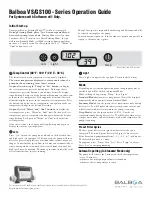
08 + ERLQ004~008
Daikin Altherma - Low Temperature Split
4P313774-1 – 2012.05
Installer reference guide
46
8 Configuration
Digital I/O PCB
Modification of these settings is only needed when the optional digital
I/O PCB is installed. The digital I/O PCB has multiple functionality
which need to be configured. See "5 Application guidelines" on
page 9.
#
Code
Description
[A.2.2.4]
[C-05]
Contact type main
In external room thermostat control, the
contact type of the optional room
thermostat or heat pump convector for
the main leaving water temperature zone
must be set. See "5 Application
guidelines" on page 9.
Q
1 (Thermo ON/OFF): The
connected external room thermostat
or heat pump convector sends the
heating or cooling demand by the
same signal as it is connected to
only 1 digital input (preserved for the
main leaving water temperature
zone) on the indoor unit (X2M/1).
Select this value in case of a
connection to the heat pump
convector (FWVX).
Q
2 (C/H request)(default): The
connected external room thermostat
sends separate heating and cooling
demand and is therefore connected
to the 2 digital input (preserved for
the main leaving water temperature
zone) on the indoor unit (X2M/1 and
2). Select this value in case of
connection with the wired
(EKRTWA) or wireless (EKRTR1)
room thermostat.
[A.2.2.5]
[C-06]
Contact type add.
In external room thermostat control with
2 leaving water temperature zones, the
type of the optional room thermostat for
the additional leaving water temperature
zone must be set. See "5 Application
guidelines" on page 9.
Q
1 (Thermo ON/OFF): See Contact
type main. Connected on the indoor
unit (X2M/1a).
Q
2 (C/H request)(default): See
Contact type main. Connected on
the indoor unit (X2M/1a and 2a).
[A.2.2.B]
[C-08]
External sensor
When an optional external ambient
sensor is connected, the type of the
sensor must be set. See "5 Application
guidelines" on page 9.
Q
0 (No)(default): NOT installed. The
thermistor in the user interface and
in the outdoor unit are used for
measurement.
Q
1 (Outdoor sensor): Installed. The
outdoor sensor will be used to
measure the outdoor ambient
temperature. Remark: For some
functionality, the temperature sensor
in the outdoor unit is still used.
Q
2 (Room sensor): Installed. The
temperature sensor in the user
interface is NOT used anymore.
Remark: This value has only
meaning in room thermostat control.
#
Code
Description
[A.2.2.6.1]
[C-02]
Ext. backup heat src
Indicates if the space heating is also
performed by means of an other heat
source that the system.
Q
0 (No)(default): NOT installed.
Q
1 (Bivalent): Installed. The auxiliary
boiler (gasboiler, oil burner) will
operate when the outdoor ambient
temperature is low. During the
bivalent operation, the heat pump is
turned OFF. Set this value in case
an auxililary boiler is used. See
"5 Application guidelines"
on
page 9.
[A.2.2.6.2]
[D-07]
Solar kit
Only applicable for EHBH/X. Indicates if
the domestic hot water tank is also
heated by thermal solar panels.
Q
0 (No)(default): NOT installed.
Q
1 (Yes): Installed. The domestic hot
water tank can –besides by the heat
pump- also be heated by thermal
solar panels. Set this value if
thermal solar panels are installed.
See "5 Application guidelines"
on
page 9.
[A.2.2.6.3]
[C-09]
Alarm output
Indicates the logic of the alarm output on
the digital I/O PCB during malfunctioning.
Q
0 (Normally open)(default): The
alarm output will be powered when
an alarm occurs. By setting this
value, a distinction is made between
malfunctioning and detection of a
power failure of the unit.
Q
1 (Normally closed): The alarm
output will NOT be powered when
an alarm occurs.
[A.2.2.6.4]
[F-04]
Bottom plate heater
Only applicable for EHBH/X16 and
EHVH/X16. Indicates if an optional
bottom plate heater is installed on the
outdoor unit. The power of the bottom
plate heater is in this case supplied by
the indoor unit.
Q
0 (No)(default): NOT installed.
Q
1 (Yes): Installed. Remark: If this
value is set, the output on the digital
I/O PCB cannot be used for space
heating/cooling output. See
"5 Application guidelines"
on
page 9.
















































